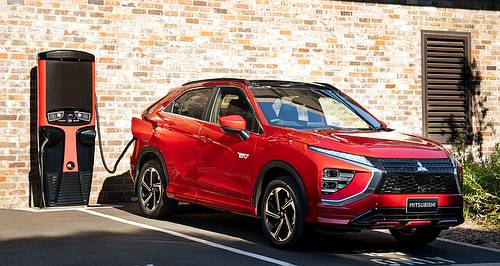EV acceptance to boost Mitsubishi Eclipse Cross PHEV

MITSUBISHI Motors Australia Limited (MMAL) earned a first-mover advantage in the plug-in hybrid SUV market when it launched the first-generation Outlander PHEV back in 2013, so this month’s launch of the smaller and more affordable Eclipse Cross PHEV could be well-timed to capitalise on increased awareness, uptake and government support for electrified vehicles.
It is a period of increased activity around electrified vehicles in this country, with PHEV SUV sales up 135.1 per cent year-to-date while hybrid and pure EV SUVs and passenger cars are also on a consistent increase, and small SUV sales continue to grow at a faster rate than medium and large SUVs.
Though the petrol-electric variants went on to only account for two per cent of the overall Outlander sales, the Eclipse Cross PHEV may make a bigger impact – and experience gained over the last eight years means MMAL has a better understanding than most of what PHEV customers want and need.
In this time, MMAL found that Outlander PHEV owners were leaning heavily on their vehicle’s battery, with 84 per cent of travel time spent in electric-only mode.
Almost three-quarters would charge their cars at least one per day and 99 per cent would charge at home to take advantage of low kilowatt-hour costs, while only seven per cent would charge at public EV charge points near their homes.
Originally slated to launch in August but delayed due to semiconductor supply issues, the Eclipse Cross PHEV’s local arrival expands MMAL’s electrified model range to two and strengthens its position in the mainstream electrified vehicle market.
The Outlander PHEV will itself get a boost next year when a second-generation model arrives, but for now the Eclipse Cross PHEV represents the cutting edge of Mitsubishi’s electrification strategy
It caps an extensive mid-life update of its small SUV family that began in December 2020 with the arrival of petrol-powered Eclipse Cross variants.
As a plug-in hybrid, the Eclipse Cross PHEV marries two electric motors and a lithium-ion battery with a combustion engine, with the engine largely employed as an on-board generator for when the battery-only range is insufficient.
With a full charge, Mitsubishi claims an electric-only range of 55km – sufficient for the daily driving demands of most drivers, the company says.
When the 13.8kWh lithium-ion battery runs dry, the 2.4-litre Atkinson-cycle petrol inline four starts in generator mode to continue supplying the two drive motors with power, extending theoretical range to more than 500km.
It is this mechanical combination that the company believes to be the best fit for Australia, which has a largely urbanised population but large distances between capitals and states.
According to MMAL’s ‘The Road to Net Zero’ white paper, released earlier this month, combining an all-electric capability with a range-extender powered by liquid fuels is a best-of-both-worlds strategy that might resonate better with typical Australian buyers.
In terms of the Eclipse Cross PHEV, the only meaningful barrier is price. Starting at $46,490 before on-roads for the base ES grade it is $5,700 more expensive than the Eclipse Cross Exceed AWD with the conventional 1.5-litre turbo powertrain.
This puts it in close competition with the Kia Niro PHEV S, which opens Kia’s PHEV range with a $49,990 drive-away pricetag, while the MG HS PHEV Essence slots in at $47,990 drive-away.
For a non-SUV option, Hyundai’s Ioniq plug-in undercuts all with a $42,410 before on-roads sticker, but exists in the less-popular small car category.
The Eclipse Cross PHEV’s three-grade line-up (consisting of ES, Aspire and Exceed) aligns closely with the equipment levels present in the conventionally-engined Eclipse Cross ES, Aspire and Exceed grades, with the primary differentiators being the electrified powertrain and some elements of the interior.
For example, the PHEV-specific transmission selector quadrant, instrument cluster and some data screens in the infotainment system are unique to the hybrid.
Boot capacity is slightly reduced due to the battery pack raising the floor height to be flush with the loading lip, bringing the total seats-up luggage capacity down to 359 litres (from 405 litres in the petrol).
However, while the price premium is considerable – spec for spec, the Eclipse Cross Exceed PHEV costs $13,200 more than the regular petrol model it’s based upon – MMAL prefers to see the PHEV range as being a distinct sub-species rather than merely a powertrain option.
The company is keen to point out that all-wheel drive, which is only available on two out six petrol-engined Eclipse Cross variants, is standard-issue on every PHEV.
Beyond that, the PHEV range also boasts phone-app remote controls for certain functions, like cabin pre-heating/cooling and charge monitoring, while a vehicle-to-grid capability is also built in that would eventually give owners the ability to use their cars as an energy storage device for their homes, or even feed energy back into the grid.
It remains to be seen whether the market decides that these value-adds are worthy of the PHEV premium, but unlike the Outlander PHEV it appears that the electrically enhanced Eclipse Cross arrives to a market that is far more favourable to vehicles of its kind.
2021 Mitsubishi Eclipse Cross PHEV pricing*
|
ES (a) |
$46,490 |
|
Aspire (a) |
$49,990 |
|
Exceed (a) |
$53,990 |
*Excludes on-road costs